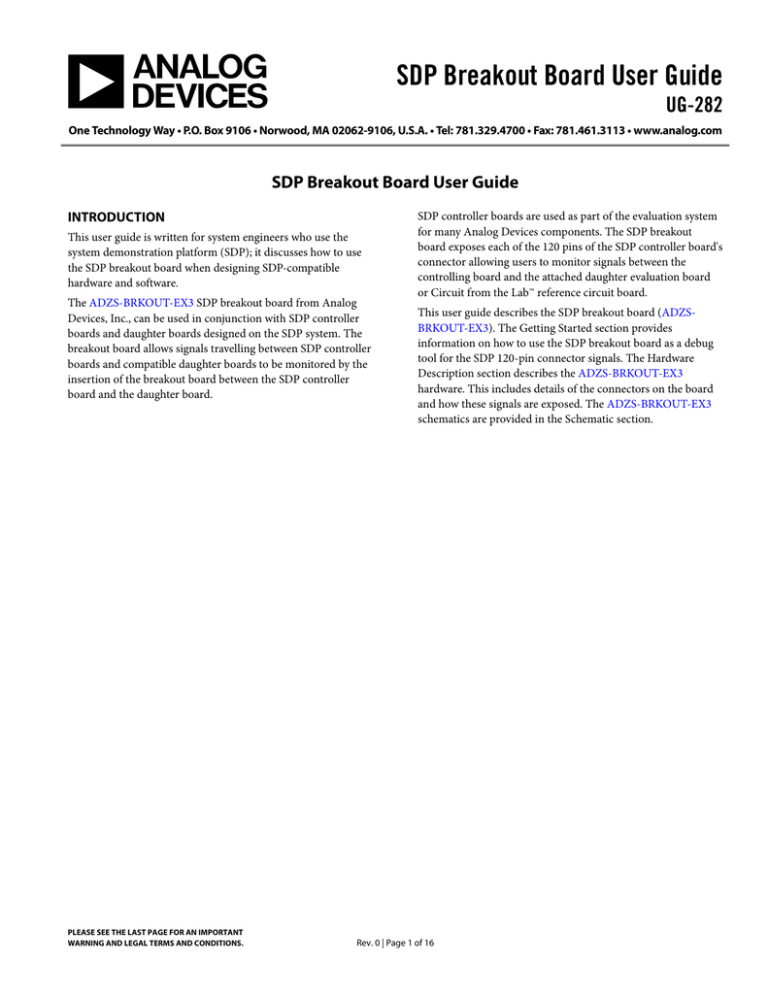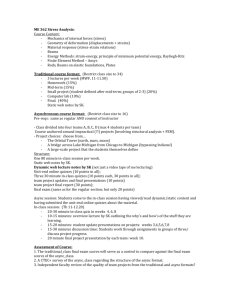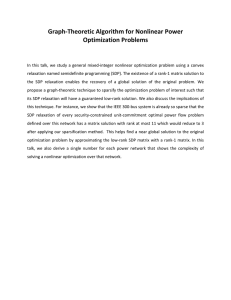SDP Breakout Board User Guide UG-282
advertisement

SDP Breakout Board User Guide UG-282 One Technology Way • P.O. Box 9106 • Norwood, MA 02062-9106, U.S.A. • Tel: 781.329.4700 • Fax: 781.461.3113 • www.analog.com SDP Breakout Board User Guide INTRODUCTION This user guide is written for system engineers who use the system demonstration platform (SDP); it discusses how to use the SDP breakout board when designing SDP-compatible hardware and software. The ADZS-BRKOUT-EX3 SDP breakout board from Analog Devices, Inc., can be used in conjunction with SDP controller boards and daughter boards designed on the SDP system. The breakout board allows signals travelling between SDP controller boards and compatible daughter boards to be monitored by the insertion of the breakout board between the SDP controller board and the daughter board. PLEASE SEE THE LAST PAGE FOR AN IMPORTANT WARNING AND LEGAL TERMS AND CONDITIONS. SDP controller boards are used as part of the evaluation system for many Analog Devices components. The SDP breakout board exposes each of the 120 pins of the SDP controller board's connector allowing users to monitor signals between the controlling board and the attached daughter evaluation board or Circuit from the Lab™ reference circuit board. This user guide describes the SDP breakout board (ADZSBRKOUT-EX3). The Getting Started section provides information on how to use the SDP breakout board as a debug tool for the SDP 120-pin connector signals. The Hardware Description section describes the ADZS-BRKOUT-EX3 hardware. This includes details of the connectors on the board and how these signals are exposed. The ADZS-BRKOUT-EX3 schematics are provided in the Schematic section. Rev. 0 | Page 1 of 16 UG-282 SDP Breakout Board User Guide TABLE OF CONTENTS Introduction ...................................................................................... 1 PC Configuration ..........................................................................4 Revision History ............................................................................... 2 Breakout Board Installation.........................................................4 Product Overview............................................................................. 3 Hardware Description.......................................................................5 Technical or Customer Support.................................................. 3 LEDs................................................................................................5 Product Information .................................................................... 3 Through-Hole Probe Points.........................................................5 Regulatory Compliance ............................................................... 3 Connector Pin Assignments ........................................................6 Getting Started .................................................................................. 4 Schematics ....................................................................................... 10 Package Contents.......................................................................... 4 REVISION HISTORY 9/11—Revision 0: Initial Version Rev. 0 | Page 2 of 16 SDP Breakout Board User Guide UG-282 PRODUCT INFORMATION PRODUCT OVERVIEW Product information can be obtained from the Analog Devices website. The SDP breakout board features • • • • • 4-pin × 120-pin small footprint connectors Hirose FX8-120P-SV1(91),120-pin header Hirose FX8-120S-SV(21), 120-pin receptacle ID EEPROM 240 through-hole probe points Analog Devices Website The Analog Devices website, http://www.analog.com, provides information about a broad range of products—analog integrated circuits, amplifiers, converters, and digital signal processors. For more information, go to http://www.analog.com/sdp. TECHNICAL OR CUSTOMER SUPPORT You can reach Analog Devices, Inc., Customer Support in the following ways: • Visit the SDP website at http://www.analog.com/sdp • Email processor questions to processor.support@analog.com (worldwide support) processor.europe@analog.com (Europe support) processor.china@analog.com (China support) • Phone questions to 1-800-ANALOGD • Contact your Analog Devices local sales office or authorized distributor. • Send questions by mail to: Analog Devices, Inc. Note that MyAnalog.com is a free feature of the Analog Devices website that allows customization of a web page to display only the latest information about products of interest to you. You can choose to receive weekly email notifications containing updates to the web pages that meet your interests, including documentation errata. MyAnalog.com provides access to books, application notes, data sheets, code examples, and more. Visit MyAnalog.com to sign up. If you are a registered user, just log on. Your user name is your email address. REGULATORY COMPLIANCE The ADZS-BRKOUT-EX3 is designed for use solely in a laboratory environment. The board is not intended for use as a consumer end product or as a portion of a consumer end product. The board is an open system design, which does not include a shielded enclosure and therefore may cause interference to other electrical devices in close proximity. This board should not be used in or near any medical equipment or RF devices. Store unused boards in the protective shipping package. Norwood, MA 02062-9106 The ADZS-BRKOUT-EX3board has been certified to comply with the essential requirements of the European EMC directive 89/36/EC, amended by 93/68/EEC, and therefore carries the CE mark. USA Three Technology Way P.O. Box 9106 Rev. 0 | Page 3 of 16 UG-282 SDP Breakout Board User Guide GETTING STARTED This section provides specific information to assist you with using the SDP breakout board as part of an SDP system. The following topics are covered. Figure 1 shows the SDP breakout board connected to an SDP-B controller board and a Circuit from the Lab reference circuit or component evaluation board. Package contents PC configuration Breakout board installation PACKAGE CONTENTS The ADZS-BRKOUT-EX3 board package contains one ADZS-BRKOUT-EX3 board. Contact the vendor where you purchased the SDP breakout board or contact Analog Devices if this item is missing. Pin 1 to Pin 30 and Pin 91 to Pin 120 from receptacle J1 are exposed in the P6 set of probe points. Pin 31 to Pin 90 are exposed in the P5 set of probe points. In this way, the SDP breakout board can be used to monitor signals travelling between the SDP controller board and the attached daughter board. PC CONFIGURATION For correct operation of an SDP controller board and SDP breakout board, your computer must have the following minimum configuration: • • Windows XP Service Pack 2 or Windows Vista® USB 2.0 port BREAKOUT BOARD INSTALLATION When removing the SDP breakout board from the package, handle the board carefully to avoid the discharge of static electricity, which can damage some components. CON B J2 The SDP breakout board exposes each of the 120 pins on the SDP-B board connector. The breakout board has a 120-pin receptacle connector (J1) which attaches to the 120-pin connector on the SDP controller board; it also has a 120-pin header connector (P1) for attaching SDP-compatible daughter boards to the system. The SDP breakout board can also be used as a proof of concept tool through the insertion of pin headers in the exposed, relevant signal through-hole locations. These pin headers can be connected to existing hardware when building up a mock-up system prior to the design of SDP-specific hardware. A J1 SDP BOARD P2 SDP-B CONTROLLER BOARD P1 CON COMPONENT EVAL / CftL DAUGHTER BOARD Figure 1. Connecting the SDP Breakout Board Rev. 0 | Page 4 of 16 09896-001 • • • The SDP breakout board is designed for use with an SDP controller board. The SDP breakout board must be connected to a PC via the SDP controller board and a USB cable. SDP Breakout Board User Guide UG-282 HARDWARE DESCRIPTION This section describes the hardware design of the ADZSBRKOUT-EX3 board. THROUGH-HOLE PROBE POINTS The following topics are covered. • • • LEDs—This section describes the SDP breakout board LEDs. Through-hole probe points—This section provides layouts of through-hole probe points on the SDP breakout board. Connector Pin Assignments—This section details the pin assignments on the 120-pin connectors. LEDS Figure 2 and Figure 3 show both sides of the SDP breakout board; the shading indicates the signal path from the receptacle to the header via the through-hole probe points. Connector J2 and P2 are for use with future Blackfin® EZ-Kit products. The signal lines between these two connectors are exposed through the probe points on P3 and P4. 09896-002 There is a single LED located on the SDP breakout board. It is connected to the input power line on the 120-pin header connector on the SDP breakout board. Therefore, when power is provided from an attached daughter board, this LED is on. If there is no power coming through the VIN pin on P1, this LED remains off. The SDP breakout board contains 240 through-hole probe points, 2 × 120 pin receptacle connector and 2 × 120 pin header connectors. One of the 120-pin receptacle connectors (J1) can be used to connect to the 120-pin connector on the SDP controller board. One of the 120-pin header connectors (P1), on the back of the SDP board, can be used to connect to a daughter board (P1). 09896-003 Figure 2. SDP Breakout Board—Top View Figure 3. SDP Breakout Board—Bottom View Rev. 0 | Page 5 of 16 UG-282 SDP Breakout Board User Guide CONNECTOR PIN ASSIGNMENTS The SDP breakout board should be connected to an SDP controller board via connector J1 and to an SDP daughter board via connector P1. With this configuration, pin assignments for P6 and P5 through-hole probe points are listed in Table 1. Table 1. 120-Pin Connector Pin Assignments Pin No. 1 2 3 4 5 6 7 8 9 10 11 12 13 14 15 16 17 18 19 20 21 22 23 24 25 26 27 28 29 30 31 32 33 34 35 36 37 38 39 Pin Name VIN NC GND GND USB_VBUS GND PAR_D23 PAR_D21 PAR_D19 PAR_D17 GND PAR_D14 PAR_D13 PAR_D11 PAR_D9 PAR_D7 GND PAR_D5 PAR_D3 PAR_D1 PAR_RD PAR_CS GND PAR_A3 PAR_A1 PAR_FS3 PAR_FS1 GND SPORT_TDV0 SPORT_TDV1 SPORT_DR1 SPORT_DT1 SPI_D2 SPI_D3 SERIAL_INT GND SPI_SEL_B SPI_SEL_C SPI_SEL1/SPI_SS 40 41 42 43 44 45 46 GND SDA_1 SCL_1 GPIO0 GPIO2 GPIO4 GND Description Power to SDP Board. Requires 200 mA at 5 V. No Connect. Leave this pin unconnected. Do not ground. Connect to ground plane of board. Connect to ground plane of board. Connected directly to the USB +5 V supply. Connect to ground plane of board. Parallel Data Bus Bit 23. (No connect.)1 Parallel Data Bus Bit 21. (No connect.)1 Parallel Data Bus Bit 19. (No connect.)1 Parallel Data Bus Bit 17. (No connect.)1 Connect to ground plane of board. Parallel Data Bus Bit 14. Parallel Data Bus Bit 13. Parallel Data Bus Bit 11. Parallel Data Bus Bit 9. Parallel Data Bus Bit 7. Connect to ground plane of board. Parallel Data Bus Bit 5. Parallel Data Bus Bit 3. Parallel Data Bus Bit 1. Asynchronous Parallel Read Strobe. Asynchronous Parallel Chip Select. Connect to ground plane of board. Parallel Address Bus Bit 3. Parallel Address Bus Bit 1. Synchronous (PPI) Parallel Frame Sync 3. Synchronous (PPI) Parallel Frame Sync 1. Connect to ground plane of board. SPI Data Line 3. (No connect.)1 SPI Data Line 2. (No connect.)1 SPORT Data Receive 1. Secondary SPORT data into processor. SPORT Data Transmit 1. Secondary SPORT data from processor. SPORT Data Line. (No connect.)1 SPORT Data Line. (No connect.)1 Serial Interrupt. Used to trigger a nonperiodic serial event. Connect to ground plane of board. SPI Chip Select B. Use this to control a second device on the SPI bus. SPI Chip Select C. Use this for a third device on the SPI bus. SPI Chip Select 1. Used to connect to SPI boot flash, if required. Also used as chip select when Blackfin processor is operating as SPI slave. Connect to ground plane of board. I2C Data 1. I2C Data 1. General-Purpose Input/Output. General-Purpose Input/Output. General-Purpose Input/Output. Connect to ground plane of board. Rev. 0 | Page 6 of 16 SDP Breakout Board User Guide Pin No. 47 48 49 50 51 52 53 54 55 56 57 58 59 60 61 62 63 64 65 66 67 68 69 70 71 72 73 74 75 76 77 78 79 80 81 82 83 84 85 86 87 88 89 90 91 92 93 94 95 96 97 98 99 Pin Name GPIO6 TMR_A TMR_C NC NC GND NC NC NC EEPROM_A0 RESET_OUT GND UART_RX RESET_IN BMODE1 UART_TX GND SLEEP WAKE NC NC NC GND NC CLKOUT TMR_D TMR_B GPIO7 GND GPIO5 GPIO3 GPIO1 SCL_0 SDA_0 GND SPI_CLK SPI_MISO SPI_MOSI SPI_SEL_A GND SPORT_TSCLK SPORT_DT0 SPORT_TFS SPORT_RFS SPORT_DR0 SPORT_RSCLK GND PAR_CLK PAR_FS2 PAR_A0 PAR_A2 GND PAR_INT UG-282 Description General-Purpose Input/Output. Timer A Flag Pin. Use as first timer, if required. Timer C Flag Pin.1 (No connect.) No Connect. Leave this pin unconnected. Do not ground. No Connect. Leave this pin unconnected. Do not ground. Connect to ground plane of board. No Connect. Leave this pin unconnected. Do not ground. No Connect. Leave this pin unconnected. Do not ground. No Connect. Leave this pin unconnected. Do not ground. EEPROM A0. Connect to A0 Address line of the EEPROM. Active low reset signal from processor board. Connect to ground plane of board. UART Receive Data. Active low pin to reset controller board. Boot Mode 1. Pull up with 10 kΩ resistor to set SDP to boot from SPI Flash. Enabled on Connector A only. UART Transmit Data. Connect to ground plane of board. Active low sleep from processor board. External wake up to processor board. No Connect. Leave this pin unconnected. Do not ground. No Connect. Leave this pin unconnected. Do not ground. No Connect. Leave this pin unconnected. Do not ground. Connect to ground plane of board. No Connect. Leave this pin unconnected. Do not ground. CLKOUT from processor. Timer D Flag Pin. Timer B Flag Pin. Use as second timer, if required. General-Purpose Input/Output. Connect to ground plane of board. General-Purpose Input/Output. General-Purpose Input/Output. General-Purpose Input/Output. I2C Clock 0. Daughter board EEPROM must be connected to this bus. I2C Data 0. Daughter board EEPROM must be connected to this bus. Connect to ground plane of board. SPI Clock. SPI Master In, Slave Out Data. SPI Master Out, Slave In Data. SPI Chip Select A. Use this to control the first device on the SPI bus. Connect to ground plane of board. SPORT Transmit Clock. SPORT Data Transmit 0. Primary SPORT data from processor. SPORT Transmit Frame Sync. SPORT Receive Frame Sync. SPORT Data Receive 0. Primary SPORT data into processor. SPORT Receive Clock. Connect to ground plane of board. Clock for Synchronous Parallel Interface (PPI). Synchronous (PPI) Parallel Frame Sync 2. Parallel Address Bus Bit 0. Parallel Address Bus Bit 2. Connect to ground plane of board. Parallel Interrupt. Used to trigger a nonperiodic parallel event. Rev. 0 | Page 7 of 16 UG-282 Pin No. 100 101 102 103 104 105 106 107 108 109 110 111 112 113 114 115 116 117 118 119 120 1 Pin Name PAR_WR PAR_D0 PAR_D2 PAR_D4 GND PAR_D6 PAR_D8 PAR_D10 PAR_D12 GND PAR_D15 PAR_D16 PAR_D18 PAR_D20 PAR_D22 GND VIO (+3.3 V) GND GND NC NC SDP Breakout Board User Guide Description Asynchronous Parallel Write Strobe. Parallel Data Bus Bit 0. Parallel Data Bus Bit 2. Parallel Data Bus Bit 4. Connect to ground plane of board. Parallel Data Bus Bit 6. Parallel Data Bus Bit 8. Parallel Data Bus Bit 10. Parallel Data Bus Bit 12. Connect to ground plane of board. Parallel Data Bus Bit 15. Parallel Data Bus Bit 16.1 (No connect.)1 Parallel Data Bus Bit 18.1 (No connect.)1 Parallel Data Bus Bit 20.1 (No connect.)1 Parallel Data Bus Bit 22. (No connect.)1 Connect to ground plane of board. +3.3 V Output. 20 mA maximum current available to power IO voltage on daughter board. Connect to ground plane of board. Connect to ground plane of board. No Connect. Leave this pin unconnected. Do not ground. No Connect. Leave this pin unconnected. Do not ground. Functionality not implemented on the SDP board. Each interface provided by the SDP is available on unique pins of the SDP 120-pin connector. The connector pin numbering scheme is outlined in Figure 4. Rev. 0 | Page 8 of 16 60 59 58 57 56 55 54 53 52 51 50 49 48 47 46 45 44 43 42 41 40 39 38 37 36 35 34 33 32 31 30 29 28 27 26 25 24 23 22 21 20 19 18 17 16 15 14 13 12 11 10 9 8 7 6 5 4 3 2 1 UG-282 RESET_IN BMODE1 UART_TX UART_RX GND GND RESET_OUT SLEEP SDP EEPROM_A0 WAKE STANDARD NC NC CONNECTOR NC NC NC NC GND GND NC NC NC NC TMR_C * TMR_D TIMERS TMR_A TMR_B GPIO6 GPIO7 GND GND GENERAL GPIO4 GPIO5 INPUT/OUTPUT GPIO2 GPIO3 GPIO0 GPIO1 SCL_1 SCL_0 I2C SDA_1 SDA_0 GND GND SPI_SEL1/SPI_SS SPI_CLK SPI_SEL_C SPI_MISO SPI SPI_SEL_B SPI_MOSI GND SPI_SEL_A SERIAL_INT GND SPI_D3 * SPORT_TSCLK SPI_D2 * SPORT_DT0 SPORT SPORT_DT1 SPORT_TFS SPORT_DR1 SPORT_RFS SPORT_TDV1 * SPORT_DR0 SPORT_TDV0 * SPORT_RSCLK GND GND PAR_FS1 PAR_CLK PAR_FS3 PAR_FS2 PAR_A1 PAR_A0 PAR_A3 PAR_A2 GND GND PAR_CS PAR_INT PAR_RD PAR_WR PAR_D1 PAR_D0 PARALLEL PAR_D3 PAR_D2 PORT PAR_D5 PAR_D4 GND GND PAR_D7 PAR_D6 PAR_D9 PAR_D8 PAR_D11 PAR_D10 PAR_D13 PAR_D12 PAR_D14 GND GND PAR_D15 * PAR_D16 PAR_D17 * * PAR_D18 PAR_D19 * * PAR_D20 PAR_D21 * * PAR_D22 PAR_D23 * GND GND USB_VBUS VIO(+3.3V) GND GND GND GND NC NC *NC ON BLACKFIN SDP VIN NC Figure 4. 120-Pin Connector Outline Rev. 0 | Page 9 of 16 61 62 63 64 65 66 67 68 69 70 71 72 73 74 75 76 77 78 79 80 81 82 83 84 85 86 87 88 89 90 91 92 93 94 95 96 97 98 99 100 101 102 103 104 105 106 107 108 109 110 111 112 113 114 115 116 117 118 119 120 09896-004 SDP Breakout Board User Guide UG-282 SDP Breakout Board User Guide SCHEMATICS This section provides the schematic drawings for the ADZS-BRKOUT-EX3 board. The schematic pages include • • • SDP breakout board—EI3 connectors SDP breakout board—probing connectors SDP breakout board—EEPROM and power Rev. 0 | Page 10 of 16 SDP Breakout Board User Guide UG-282 J1 J1-95 J1-101 J1-102 J1-103 J1-105 J1-106 J1-107 J1-108 J1-12 J1-111 J1-112 J1-113 J1-114 J1-99 J1-87 J1-89 J1-29 J1-88 J1-32 J1-35 J1-82 J1-83 J1-33 J1-39 J1-37 J1-61 TWI0_A0 SCL0 SDA0 J1-43 J1-44 J1-45 J1-47 P1 94 PPI0_CLK 95 PPI0_FS2 PPI_FS1 27 PPI0_FS3 26 J1-27 J1-94 J1-26 J1-95 101 PPI0_D0 102 PPI0_D2 PPI0_D1 20 PPI0_D3 19 J1-20 J1-101 J1-19 J1-102 103 PPI0_D4 105 PPI0_D6 106 PPI0_D8 107 PPI0_D10 108 PPI0_D12 PPI0_D5 18 PPI0_D7 16 J1-18 J1-16 J1-105 PPI0_D9 15 PPI0_D11 14 J1-15 J1-106 J1-14 J1-107 PPI0_D13 13 PPI0_D15 110 J1-13 J1-108 J1-110 J1-12 PPI0_D17 10 PPI0_D19 9 J1-10 J1-111 J1-9 J1-112 PPI0_D21 8 PPI0_D23 7 J1-8 J1-113 J1-7 J1-114 12 PPI0_D14 111 PPI0_D16 112 PPI0_D18 113 PPI0_D20 114 PPI0_D22 99 PPI0_INT SPORT1_CLK 92 SPORT1_FS 90 29 SPORT0_TDV 88 SPORT0_D0 SPORT1_TDV 30 SPORT1_D0 91 SPORT1_D1 31 82 SPI0_CLK 83 SPI0_MISO 33 SPI0_D2 39 SPI0_SEL1/ SPI0_SS* 37 SPI0_SEL_B 61 EXT_BOOT 56 TWI0_A0* 79 SCL0* 80 SDA0* 43 GPIO0 44 GPIO2 45 GPIO4 47 GPIO6 J1-49 48 TMR_A 49 TMR_C J1-59 59 UART0_RX J1-65 65 WAKE* J1-60 60 RESET_IN* J1-71 71 CLKOUT J1-48 VIN PS_IN 1 VIN 120 PS_IN 3 GND1 GND 6 GND3 17 GND5 28 GND7 40 GND9 52 GND11 63 GND13 75 GND15 86 GND17 98 GND19 109 GND21 J1-2 J1-22 J1-25 J1-53 J1-55 J1-87 J1-90 J1-89 J1-30 J1-29 J1-91 J1-88 J1-31 J1-32 J1-35 SPI0_RDY 50 SPI0_MOSI 84 SPI0_D3 34 SPI0_SEL_A 85 J1-50 J1-82 J1-84 J1-83 J1-34 J1-33 J1-85 J1-39 38 J1-38 J1-37 SPI0_SEL_C J1-61 TWI0_A0 SCL1* 42 J1-42 SCL0 SDA1* 41 J1-41 SDA0 GPIO1 78 77 GPIO3 GPIO5 76 GPIO7* 74 J1-78 J1-43 J1-77 J1-44 J1-76 J1-45 J1-38 SCL1* 42 SDA1* 41 J1-42 J1-78 45 GPIO4 47 GPIO6 GPIO1 78 GPIO3 77 GPIO5 76 GPIO7* 74 J1-74 TMR_B 73 TMR_D* 72 J1-73 UART0_TX 62 J1-62 SLEEP* 64 J1-64 RESET_OUT* 57 J1-57 56 TWI0_A0* 79 SCL0* 80 SDA0* 43 GPIO0 44 GPIO2 SLEEP* 64 J1-64 J1-65 65 WAKE* J1-60 60 RESET_IN* J1-71 71 CLKOUT VIN GND2 4 GND4 11 GND6 23 GND8 36 GND10 46 GND12 58 1 VIN 120 PS_IN GND20 104 GND22 115 J1-2 J1-24 J1-22 RSVD6 51 RSVD8 54 J1-51 J1-25 J1-54 J1-53 RSVD10 66 RSVD12 68 J1-66 J1-55 J1-68 J1-67 RSVD14 96 RSVD16 100 J1-96 J1-70 J1-100 USB_VCC 5 VIO 116 GND3 GND1 6 GND3 17 GND5 GND2 4 GND4 11 GND6 23 28 GND7 40 GND9 GND8 36 GND10 46 GND12 58 GND14 69 81 52 GND11 63 GND13 75 GND15 86 GND17 GND14 69 GND16 81 GND18 93 J1-7 GND16 GND18 98 GND19 109 GND21 117 GND23 GND20 J1-91 J1-31 J1-84 J1-34 J1-85 J1-41 J1-77 J1-76 J1-72 USB_VCC VIO 93 104 115 GND24 118 2 RSVD1 22 RSVD3 25 RSVD5 RSVD2 21 J1-21 RSVD4 24 J1-24 RSVD6 51 J1-51 53 RSVD7 55 RSVD9 RSVD8 54 J1-54 RSVD10 66 J1-66 RSVD12 68 J1-68 RSVD14 96 J1-96 RSVD16 100 J1-100 J1-97 J1-119 119 RSVD17 HIROSE_FX8-120P-SV1(91)T Figure 5. SDP Breakout Board—EI3 Connectors Rev. 0 | Page 11 of 16 J1-90 GND22 67 RSVD11 70 RSVD13 97 RSVD15 HIROSE_FX8-120S-SV(21) J1-8 SPI0_SEL_C 38 59 UART0_RX PS_IN J1-9 PPI0_D23 7 J1-10 J1-50 J1-59 VIO J1-110 PPI0_D19 9 PPI0_D21 8 J1-13 SPI0_RDY 50 SPI0_MOSI 84 SPI0_D3 34 SPI0_SEL_A 85 82 SPI0_CLK 83 SPI0_MISO 33 SPI0_D2 39 SPI0_SEL1/ 37 SPI0_SS* SPI0_SEL_B 61 EXT_BOOT J1-62 USB_VCC J1-14 PPI0_D15 110 PPI0_D17 10 J1-15 J1-30 32 SPORT0_D1 35 SPORT_INT 62 USB_VCC 5 VIO 116 J1-16 PPI0_D11 14 PPI0_D13 13 J1-18 J1-92 J1-49 J1-57 J1-19 PPI0_D7 16 PPI0_D9 15 J1-20 SPORT1_TDV 30 SPORT1_D0 91 SPORT1_D1 31 J1-72 RESET_OUT* PPI0_D3 19 PPI0_D5 18 J1-26 SPORT1_CLK 92 SPORT1_FS 90 TMR_D* 72 57 J1-27 29 SPORT0_TDV 88 SPORT0_D0 48 TMR_A 49 TMR_C UART0_TX PPI_FS1 27 PPI0_FS3 26 PPI0_D1 20 87 SPORT0_CLK 89 SPORT0_FS J1-48 73 J1-21 J1-119 12 PPI0_D14 111 PPI0_D16 112 PPI0_D18 113 PPI0_D20 114 PPI0_D22 99 PPI0_INT J1-73 TMR_B RSVD2 21 RSVD4 24 119 RSVD17 103 PPI0_D4 105 PPI0_D6 106 PPI0_D8 107 PPI0_D10 108 PPI0_D12 J1-47 2 RSVD1 22 RSVD3 25 RSVD5 53 RSVD7 55 RSVD9 101 PPI0_D0 102 PPI0_D2 J1-74 GND24 118 J1-97 J1-70 J1-92 117 GND23 67 RSVD11 70 RSVD13 97 RSVD15 J1-67 J1-99 87 SPORT0_CLK 89 SPORT0_FS 32 SPORT0_D1 35 SPORT_INT J1-103 94 PPI0_CLK 95 PPI0_FS2 09896-005 J1-94 UG-282 SDP Breakout Board User Guide P2 J2-10 J2-21 J2-22 J2-26 J2-29 J2-31 J2-33 J2-35 J2-38 J2-41 J2-43 J2-45 J2-95 J2-97 J2-101 J2-102 J2-103 J2-105 J2-106 J2-107 J2-108 J2-110 J2-47 J2-49 J2-51 J2-54 J2-57 J2-56 J2-73 J2-64 J2-66 J2-68 J2-72 VIN PS_IN J2-2 J2-61 J2-74 J2-77 J2-79 J2-82 J2-84 J2-87 J2-89 J2-91 J2-100 J2-112 J2-114 8 ASYNC_AMS0 10 ASYNC_AMS3 21 ASYNC_ARDY 22 ASYNC_BR 26 ASYNC_A4 29 ASYNC_A6 31 ASYNC_A8 33 ASYNC_A10 35 ASYNC_A12 38 ASYNC_A14 41 ASYNC_A16 43 ASYNC_A18 45 ASYNC_A20 95 ASYNC_A22 97 ASYNC_A24 101 ASYNC_D16 102 ASYNC_D18 103 ASYNC_D120 105 ASYNC_D22 106 ASYNC_D24 107 ASYNC_D26 108 ASYNC_D28 110 ASYNC_D31 J2-9 J2-8 8 ASYNC_AMS0 J2-7 J2-10 10 ASYNC_AMS3 ASYNC_BGH 25 ASYNC_BG 24 J2-25 J2-21 21 ASYNC_ARDY J2-24 J2-22 22 ASYNC_BR ASYNC_A5 27 ASYNC_A7 30 J2-27 J2-26 26 ASYNC_A4 J2-30 J2-29 29 ASYNC_A9 32 ASYNC_A11 34 J2-32 J2-31 J2-34 ASYNC_A13 37 ASYNC_A15 39 ASYNC_AMS2 9 ASYNC_AOE 7 ASYNC_AMS2 9 ASYNC_AOE 7 J2-9 J2-7 ASYNC_BGH 25 ASYNC_BG 24 J2-25 ASYNC_A5 27 J2-27 ASYNC_A6 ASYNC_A7 30 J2-30 31 ASYNC_A8 ASYNC_A9 32 J2-32 J2-33 33 ASYNC_A10 ASYNC_A11 34 J2-34 J2-37 J2-35 35 ASYNC_A12 ASYNC_A13 37 J2-37 J2-39 J2-38 38 ASYNC_A14 ASYNC_A15 39 J2-39 ASYNC_A17 42 ASYNC_A19 44 J2-42 J2-41 41 ASYNC_A16 ASYNC_A17 42 J2-42 J2-44 J2-43 43 ASYNC_A18 ASYNC_A19 44 J2-44 ASYNC_A21 94 ASYNC_A23 96 J2-94 J2-45 45 ASYNC_A20 ASYNC_A21 94 J2-94 J2-96 J2-95 95 ASYNC_A22 ASYNC_A23 96 J2-96 ASYNC_A25 99 ASYNC_D17 20 J2-99 J2-97 97 ASYNC_A24 ASYNC_A25 99 J2-99 J2-20 J2-101 ASYNC_D17 20 J2-20 ASYNC_D19 19 ASYNC_D21 18 J2-19 J2-102 101 ASYNC_D16 102 ASYNC_D18 ASYNC_D19 19 J2-19 J2-18 J2-103 ASYNC_D21 18 J2-18 ASYNC_D23 16 ASYNC_D25 15 J2-16 J2-105 ASYNC_D23 16 J2-16 J2-15 J2-106 ASYNC_D25 15 J2-15 ASYNC_D27 14 ASYNC_D29 13 J2-14 J2-107 ASYNC_D26 ASYNC_D27 14 J2-14 J2-13 J2-108 108 ASYNC_D28 110 ASYNC_D31 ASYNC_D29 13 J2-13 ASYNC_D30 12 J2-12 103 ASYNC_D120 105 ASYNC_D22 106 ASYNC_D24 107 J2-24 ASYNC_D30 12 J2-12 J2-110 47 PWM0_AH 49 PWM0_BH PWM0_AL 48 PWM0_BL 50 J2-48 J2-47 47 PWM0_AH PWM0_AL 48 J2-48 J2-50 J2-49 49 PWM0_BH PWM0_BL 50 J2-50 51 PWM0_CH 54 PWM0_DH PWM0_CL 53 PWM0_DL 55 J2-53 J2-51 51 PWM0_CH PWM0_CL 53 J2-53 J2-55 J2-54 54 PWM0_DH PWM0_DL 55 J2-55 J2-57 57 PWM0_TRIP0 PWM0_TRIP1 59 J2-59 J2-56 56 PWM0_SYNC 57 PWM0_TRIP0 56 PWM0_SYNC 73 ACM0_CLK 64 ACM0_A0 66 ACM0_A2 68 ACM0_A4 72 ACM0_T1 1 VIN 120 PS_IN PWM0_TRIP1 59 J2-59 73 ACM0_FS 70 ACM0_A1 65 J2-70 J2-73 ACM0_CLK ACM0_FS 70 J2-70 J2-65 J2-64 64 ACM0_A0 ACM0_A1 65 J2-65 ACM0_A3 67 ACM0_T0 71 J2-67 J2-66 66 ACM0_A2 ACM0_A3 67 J2-67 J2-68 68 ACM0_A4 ACM0_T0 71 J2-71 J2-72 72 ACM0_T1 USB_VCC 5 USB_VCC 116 VIO USB_VCC 5 VIO 116 J2-71 VIN 1 PS_IN 120 USB_VCC VIO VIN PS_IN VIO 3 GND1 GND2 4 3 GND1 GND2 4 6 GND3 GND4 11 6 GND3 GND4 11 17 GND5 28 GND7 GND6 23 17 GND5 GND6 23 GND8 36 28 GND7 GND8 36 40 GND9 52 GND11 GND10 46 40 GND9 GND10 46 GND12 58 52 GND11 GND12 58 63 GND13 75 GND15 86 GND17 GND14 69 63 GND13 GND14 69 81 75 GND15 GND16 93 86 GND17 GND18 104 98 GND19 GND20 115 109 GND21 GND22 117 GND23 GND24 118 GND16 GND18 81 93 104 98 GND19 109 GND21 117 GND23 GND20 GND24 118 2 RSVD1 61 RSVD3 74 RSVD5 RSVD2 60 J2-60 J2-2 2 RSVD1 RSVD2 60 J2-60 RSVD4 62 J2-62 J2-61 61 RSVD3 RSVD4 62 J2-62 RSVD6 76 J2-76 J2-74 74 RSVD5 RSVD6 76 J2-76 RSVD8 78 J2-78 J2-77 RSVD7 RSVD8 78 J2-78 RSVD10 80 83 RSVD12 85 RSVD14 RSVD16 88 J2-80 J2-79 RSVD9 RSVD10 80 J2-80 RSVD18 90 RSVD20 92 77 79 RSVD7 RSVD9 82 RSVD11 84 RSVD13 87 89 91 RSVD15 RSVD17 RSVD19 100 RSVD21 112 RSVD23 114 RSVD25 GND22 RSVD22 RSVD24 RSVD26 111 113 119 J2-83 J2-82 77 79 82 84 J2-85 J2-84 J2-88 J2-87 J2-90 J2-89 J2-92 J2-91 J2-111 J2-100 100 J2-112 112 J2-113 J2-119 J2-114 HIROSE_FX8-120S-SV(21) 87 89 91 114 RSVD11 RSVD12 83 85 J2-83 RSVD13 RSVD14 RSVD15 RSVD16 88 J2-88 RSVD17 RSVD18 90 J2-90 RSVD19 RSVD20 92 J2-92 RSVD21 RSVD22 RSVD23 RSVD25 RSVD24 RSVD26 HIROSE_FX8-120P-SV1(91) Figure 6. SDP Breakout Board—Probing Connectors Rev. 0 | Page 12 of 16 115 111 113 119 J2-85 J2-111 J2-113 J2-119 09896-008 J2 J2-8 SDP Breakout Board User Guide UG-282 VIO D1 BAT54 200MA SOT23D C1 0.1UF 0402 VIO J3 1 R8 100K 0402 R1 100K 0402 R6 0 0402 U1 TWI0_A0 R4 100K 0402 R5 0 0402 R7 0 0402 VCC E0 E1 E2 GND CON005 SCL0 SCL 6 SDA 5 R3 1K 0603 R2 0 0402 LED1 GREEN LED001 SDA0 WC 7 M24C02 TSSOP8DW 09896-007 8 1 2 3 4 2 3 VIN Figure 7. SDP Breakout Board—EEPROM and Power Rev. 0 | Page 13 of 16 UG-282 SDP Breakout Board User Guide NOTES Rev. 0 | Page 14 of 16 SDP Breakout Board User Guide UG-282 NOTES Rev. 0 | Page 15 of 16 UG-282 SDP Breakout Board User Guide NOTES ESD Caution ESD (electrostatic discharge) sensitive device. Charged devices and circuit boards can discharge without detection. Although this product features patented or proprietary protection circuitry, damage may occur on devices subjected to high energy ESD. Therefore, proper ESD precautions should be taken to avoid performance degradation or loss of functionality. Legal Terms and Conditions By using the evaluation board discussed herein (together with any tools, components documentation or support materials, the “Evaluation Board”), you are agreeing to be bound by the terms and conditions set forth below (“Agreement”) unless you have purchased the Evaluation Board, in which case the Analog Devices Standard Terms and Conditions of Sale shall govern. Do not use the Evaluation Board until you have read and agreed to the Agreement. Your use of the Evaluation Board shall signify your acceptance of the Agreement. This Agreement is made by and between you (“Customer”) and Analog Devices, Inc. (“ADI”), with its principal place of business at One Technology Way, Norwood, MA 02062, USA. Subject to the terms and conditions of the Agreement, ADI hereby grants to Customer a free, limited, personal, temporary, non-exclusive, non-sublicensable, non-transferable license to use the Evaluation Board FOR EVALUATION PURPOSES ONLY. Customer understands and agrees that the Evaluation Board is provided for the sole and exclusive purpose referenced above, and agrees not to use the Evaluation Board for any other purpose. Furthermore, the license granted is expressly made subject to the following additional limitations: Customer shall not (i) rent, lease, display, sell, transfer, assign, sublicense, or distribute the Evaluation Board; and (ii) permit any Third Party to access the Evaluation Board. As used herein, the term “Third Party” includes any entity other than ADI, Customer, their employees, affiliates and in-house consultants. The Evaluation Board is NOT sold to Customer; all rights not expressly granted herein, including ownership of the Evaluation Board, are reserved by ADI. CONFIDENTIALITY. This Agreement and the Evaluation Board shall all be considered the confidential and proprietary information of ADI. Customer may not disclose or transfer any portion of the Evaluation Board to any other party for any reason. Upon discontinuation of use of the Evaluation Board or termination of this Agreement, Customer agrees to promptly return the Evaluation Board to ADI. ADDITIONAL RESTRICTIONS. Customer may not disassemble, decompile or reverse engineer chips on the Evaluation Board. Customer shall inform ADI of any occurred damages or any modifications or alterations it makes to the Evaluation Board, including but not limited to soldering or any other activity that affects the material content of the Evaluation Board. Modifications to the Evaluation Board must comply with applicable law, including but not limited to the RoHS Directive. TERMINATION. ADI may terminate this Agreement at any time upon giving written notice to Customer. Customer agrees to return to ADI the Evaluation Board at that time. LIMITATION OF LIABILITY. THE EVALUATION BOARD PROVIDED HEREUNDER IS PROVIDED “AS IS” AND ADI MAKES NO WARRANTIES OR REPRESENTATIONS OF ANY KIND WITH RESPECT TO IT. ADI SPECIFICALLY DISCLAIMS ANY REPRESENTATIONS, ENDORSEMENTS, GUARANTEES, OR WARRANTIES, EXPRESS OR IMPLIED, RELATED TO THE EVALUATION BOARD INCLUDING, BUT NOT LIMITED TO, THE IMPLIED WARRANTY OF MERCHANTABILITY, TITLE, FITNESS FOR A PARTICULAR PURPOSE OR NONINFRINGEMENT OF INTELLECTUAL PROPERTY RIGHTS. IN NO EVENT WILL ADI AND ITS LICENSORS BE LIABLE FOR ANY INCIDENTAL, SPECIAL, INDIRECT, OR CONSEQUENTIAL DAMAGES RESULTING FROM CUSTOMER’S POSSESSION OR USE OF THE EVALUATION BOARD, INCLUDING BUT NOT LIMITED TO LOST PROFITS, DELAY COSTS, LABOR COSTS OR LOSS OF GOODWILL. ADI’S TOTAL LIABILITY FROM ANY AND ALL CAUSES SHALL BE LIMITED TO THE AMOUNT OF ONE HUNDRED US DOLLARS ($100.00). EXPORT. Customer agrees that it will not directly or indirectly export the Evaluation Board to another country, and that it will comply with all applicable United States federal laws and regulations relating to exports. GOVERNING LAW. This Agreement shall be governed by and construed in accordance with the substantive laws of the Commonwealth of Massachusetts (excluding conflict of law rules). Any legal action regarding this Agreement will be heard in the state or federal courts having jurisdiction in Suffolk County, Massachusetts, and Customer hereby submits to the personal jurisdiction and venue of such courts. The United Nations Convention on Contracts for the International Sale of Goods shall not apply to this Agreement and is expressly disclaimed. ©2011 Analog Devices, Inc. All rights reserved. Trademarks and registered trademarks are the property of their respective owners. UG09896-0-9/11(0) Rev. 0 | Page 16 of 16








